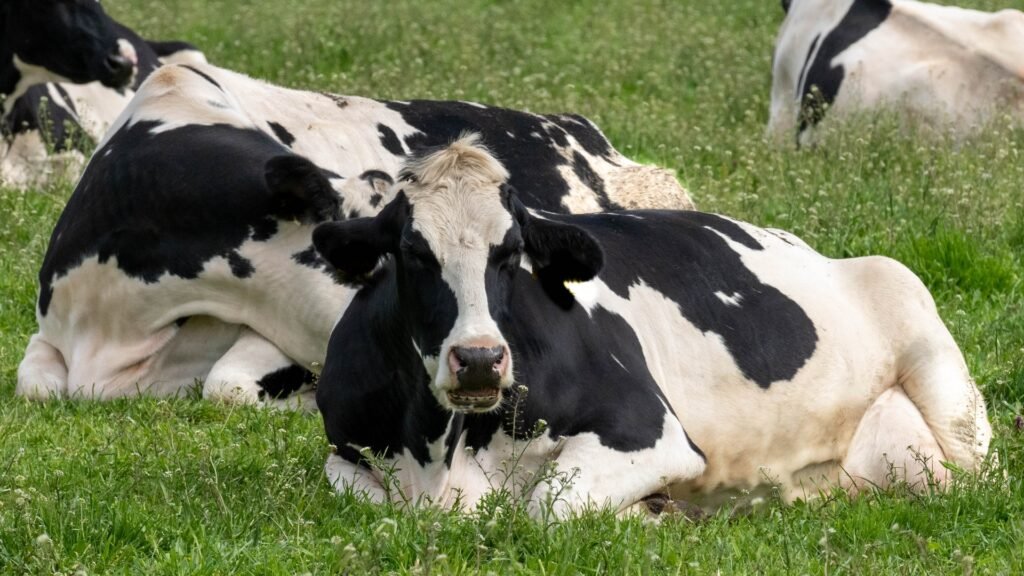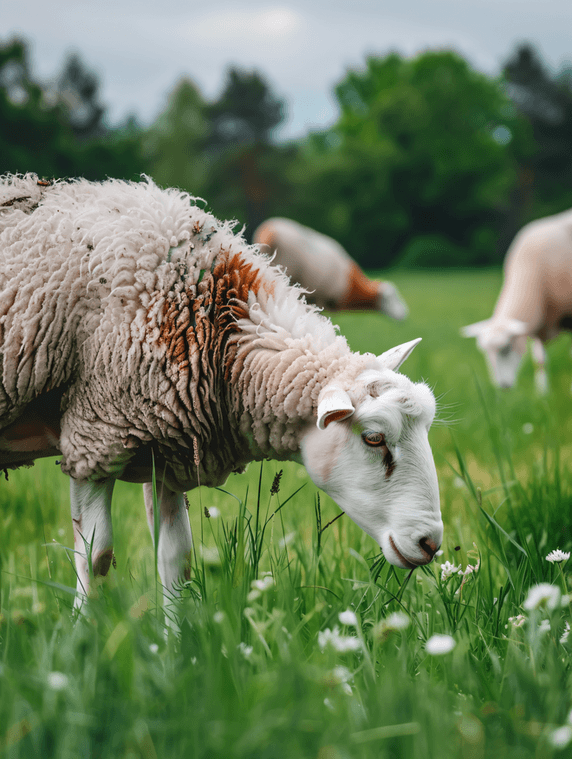In this article, we will explore the significance of magnesium in animal nutrition, the properties of feed-grade magnesium oxide (MgO), its benefits for livestock, and how to effectively incorporate it into animal diets.
Table of Contents
Introduction: Background and Importance of Magnesium in Animal Nutrition
The Basic Role of Magnesium
Magnesium is one of the most abundant minerals in the animal body, contributing to several vital physiological functions. Approximately 65% of the total magnesium is stored in the skeleton, where it binds to calcium and phosphorus, contributing to bone growth and stability. The remaining magnesium exists in its ionized form (Mg²⁺) inside the cells, where it plays a role in maintaining cellular equilibrium and supports the function of over 300 enzymes involved in energy and antioxidant metabolism. Furthermore, magnesium is necessary for nerve transmission and muscle contraction, ensuring proper muscular function and neurological health (Suttle, 2010).
The Impact of Magnesium Deficiency
Magnesium deficiency can lead to various health issues in livestock, especially in ruminants. One of the most common problems is grass tetany (hypomagnesemia), which occurs when animals graze on young grass that is high in potassium but low in magnesium. This imbalance can cause a sudden drop in magnesium levels in the blood, leading to symptoms such as neuromuscular hyperexcitability, behavioral changes, and even seizures. Additionally, magnesium deficiency can result in reduced milk production, lower weight gain, and impaired reproduction in dairy cows and other livestock.
Definition and Properties of Feed-Grade Magnesium Oxide Powder
Chemical Composition and Appearance
Feed-grade magnesium oxide powder (MgO) is a vital source of magnesium in animal diets. It is typically produced through the calcination of magnesium carbonate, resulting in a product with a high magnesium content of 50-56%. Magnesium oxide is usually a white or light gray powder, and it is highly effective in addressing magnesium deficiency in animals.
Different Types of Magnesium Oxide Powder
There are different forms of MgO powder available for animal nutrition. Feed-grade mgo powder is specifically processed to meet the purity requirements for use in livestock feeds. The primary difference between industrial and feed-grade magnesium oxide powder lies in the purity and safety standards, as the latter is free from harmful impurities and meets the nutritional needs of animals.
Solubility and Bioavailability
Magnesium oxide powder has a relatively low solubility in water, which may limit its immediate bioavailability. However, in the animal digestive system, particularly in ruminants, it is gradually dissolved in the rumen, where it releases magnesium ions (Mg²⁺) for absorption. The bioavailability of magnesium oxide powder is significantly affected by its particle size, with finer particles being more readily absorbed and utilized by livestock.
Applications and Usage Methods
Supplementing Magnesium in Animal Diets
Magnesium is typically supplemented in livestock feeds to address deficiencies and ensure optimal health. Magnesium oxide powder is commonly added to the diets of dairy cows, beef cattle, sheep, and other ruminants. In some cases, it is also used in the diets of non-ruminants such as pigs and poultry, though the dosage and absorption rates may differ.
-
- Ruminants (Cattle and Sheep): For ruminants, magnesium oxide powder is often included in their daily diet to prevent magnesium deficiency and to support optimal ruminal function. Supplementation is particularly important in the spring when livestock graze on grass, which may be low in magnesium and high in potassium.
-
- Other Livestock: For other species like pigs and poultry, magnesium oxide may be added in smaller amounts, as their magnesium requirements are generally lower than those of ruminants.
-
- Recommended Dosages and Ratios

The amount of MgO powder added to animal feeds varies depending on the species, age, and production phase of the animals. For dairy cows, the National Research Council (NRC) recommends a minimum of 0.2% magnesium in the dry matter of their daily diet to prevent deficiency. For calves, sheep, and other livestock, the dosage may vary based on their specific nutritional needs.
Health Benefits and Clinical Effects
Preventing and Treating Magnesium Deficiency
Supplementing with feed-grade magnesium oxide is an effective way to prevent and treat magnesium deficiency in livestock. This supplementation helps avoid conditions such as grass tetany and other metabolic disorders caused by low blood magnesium levels. In addition, it prevents muscle spasms, behavioral changes, and ensures overall better health for animals.
Enhancing Production Performance
MgO powder supplementation has been shown to have positive effects on livestock productivity. For dairy cows, adequate magnesium levels can improve milk production, while for beef cattle, it can support optimal growth rates. Research has demonstrated that cows receiving proper magnesium supplementation tend to have better feed conversion rates and higher reproductive performance, including improved fertility rates.
Improving Overall Animal Health
Magnesium also plays a critical role in maintaining animal health beyond just preventing deficiency. It supports the nervous system, reduces stress responses, and enhances immune function, making animals less susceptible to infections and other diseases.
Market Trends and Product Selection
Choosing High-Quality Feed-Grade Magnesium Oxide Powder
When selecting feed-grade magnesium oxide powder, there are several important factors to consider:
-
- Purity: It is essential to choose MgO powder with a high purity level, free from contaminants and harmful substances that could negatively affect animal health.
-
- Particle Size: Finer particle sizes improve the bioavailability of MgO powder, ensuring better absorption by animals. Therefore, selecting the right particle size is crucial for maximizing the effectiveness of supplementation.
-
- Certifications and Standards: Ensure that the magnesium oxide product complies with local and international standards for animal feed, such as ISO certifications, HACCP (Hazard Analysis Critical Control Point), and other safety regulations. These certifications guarantee the quality and safety of the product.
-
-
Recommended Supplier: CHIMAG for Premium Feed-Grade Magnesium Oxide
If you’re looking for a trusted supplier of MgO powder for animal feed, consider CHIMAG, a leading expert in the magnesium oxide industry. With 12 state-of-the-art production lines and an impressive annual output of over 30,000 tons, CHIMAG has established itself as a reliable source for high-quality feed-grade magnesium oxide (feed MGO), designed to support the health and productivity of livestock around the world.
Why Choose CHIMAG for Feed-Grade Magnesium Oxide powder?
-
Extensive Production Capacity: CHIMAG operates 12 advanced production lines in China, ensuring an impressive output capacity of over 30,000 tons of magnesium oxide annually. This scale allows for consistent supply and the ability to meet global demand.
-
Global Reach: Serving markets across the globe, including Turkey, India, Russia, and many other countries, CHIMAG has a wide-reaching distribution network that ensures timely and reliable delivery, no matter where your business is located.
-
Tailored Magnesium Oxide Solutions: CHIMAG offers high-quality magnesium oxide products for a variety of livestock species, including dairy cows, beef cattle, and poultry. Their products are specifically designed to enhance bone health, muscle function, and overall animal well-being, ensuring optimal growth and productivity.
-
-
Dosage Recommendations and Precautions for Feed-Grade Magnesium Oxide Powder
When supplementing livestock diets with feed-grade magnesium oxide powder, it’s crucial to provide the correct dosage to ensure that animals receive sufficient magnesium without exceeding the recommended limits, which could cause negative health effects such as diarrhea or digestive issues.
General Dosage Guidelines:
| Animal Type | Recommended Magnesium Intake | Magnesium Oxide Supplementation (g/day) | Notes/Considerations |
| Dairy Cows | 0.2% of dry matter (NRC, 2001) | 10–25 grams per cow per day | Adjust based on milk production, body weight, and pasture conditions. Monitor for grass tetany during spring. |
| Beef Cattle | 0.1–0.2% of dry matter | 15–20 grams per animal per day | Requirements can vary based on weight, growth rate, and diet. High-energy diets improve magnesium absorption. |
| Sheep and Goats | 0.1–0.2% of dry matter | 5–10 grams per animal per day | Important during spring grazing when magnesium levels in pasture are low. |
| Pigs (Swine) | 0.1–0.3% of total feed | 2–5 grams per animal per day | Often used for reproductive sows or growing pigs to promote overall health and growth. |
| Poultry (Chickens) | 0.1–0.3% of total feed | 2–5 grams per animal per day | Helps with general health, especially during periods of stress or rapid growth. |
| Other Livestock (e.g., Horses) | 0.1–0.2% of dry matter | 5–10 grams per animal per day | Magnesium supplementation may be needed in horses under high workload or stress. |
Precautions
-
- Excessive Magnesium: Over-supplementing magnesium can lead to toxicity, particularly if intake exceeds 0.4% of dry matter. Symptoms of toxicity may include diarrhea, poor digestion, and reduced feed intake. It is crucial to monitor magnesium levels carefully and adjust feed formulations accordingly to avoid exceeding the recommended daily intake.
-
- Balanced Diet: Magnesium absorption can be affected by the presence of other minerals, especially calcium, potassium, and phosphorus. High levels of potassium in the diet, for example, can reduce magnesium absorption. Ensuring a balanced diet with proper ratios of these key minerals is essential for maximizing magnesium bioavailability and preventing deficiencies.
Regulations for the Use of Feed-Grade Magnesium Oxide Powder
The use of feed-grade magnesium oxide powder is regulated differently in various countries and regions. Understanding these regulations is crucial for compliance and ensuring that livestock receive safe, effective magnesium supplementation.

United States
In the U.S., the use of MGO powder in animal feed is regulated by the Association of American Feed Control Officials (AAFCO) and the Food and Drug Administration (FDA). AAFCO sets guidelines for safe mineral levels in livestock feeds, including the use of magnesium oxide as a feed supplement. The product must meet specific quality standards, ensuring that it is free from contaminants and safe for consumption by animals. The National Research Council (NRC) also provides guidelines for the appropriate inclusion levels of magnesium in ruminant diets, including dairy cattle and beef cattle.
European Union
In the European Union, feed-grade magnesium oxide powder is regulated by the European Food Safety Authority (EFSA), which establishes standards for its use in livestock diets. EFSA provides detailed guidelines on the maximum allowable levels of magnesium in animal feeds to prevent toxicity. Similar to the U.S., products must meet quality standards to ensure that they are safe for animal consumption, and manufacturers must ensure that magnesium oxide supplements are properly labeled with their magnesium content.
Southeast Asia
Countries in Southeast Asia, such as Thailand, Vietnam, and Indonesia, have adopted regulations for MGO powder in livestock feed based on international standards, particularly those set by the Food and Agriculture Organization (FAO) and the World Health Organization (WHO). While regulations may vary slightly between countries, the overall approach to magnesium oxide use in feed is similar, emphasizing safe levels of supplementation to support animal health while avoiding over-supplementation and toxicity.
India
In India, the use of feed-grade magnesium oxide powder is governed by the Food Safety and Standards Authority of India (FSSAI). FSSAI establishes quality standards for animal feed ingredients, including magnesium oxide, ensuring that the product is free from harmful contaminants and safe for livestock consumption. Similar to other regions, it is important for feed manufacturers to comply with FSSAI regulations, ensuring the appropriate dosage and safe use of magnesium oxide in livestock diets. This is particularly important for dairy cattle and beef cattle, as magnesium deficiency is a known issue in these species, especially during the grazing season.
Conclusion
Feed-grade magnesium oxide powder is an essential mineral supplement that helps ensure optimal magnesium intake for livestock, preventing deficiency-related diseases and promoting overall animal health. By understanding the role of magnesium, selecting high-quality products, and following proper supplementation guidelines, farmers can enhance their livestock’s productivity and well-being, leading to healthier animals and more efficient farming operations.


